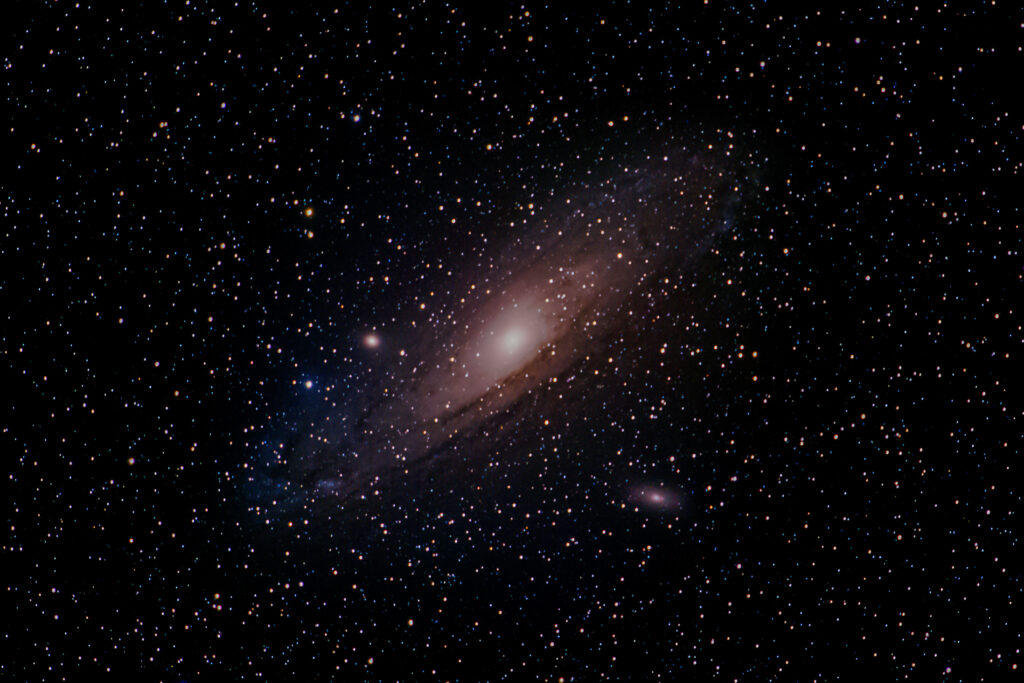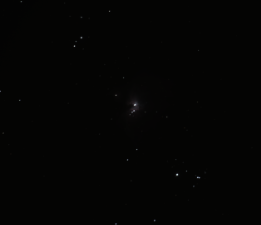Imaging Andromeda
(and the Orion Nebula)
5/3/24

Although I write this post in may of 2024, these photos were taken in October of 2023.
The Andromeda galaxy is the nearest galaxy to the milky way. About 2.5 million lightyears away. Its appearance in the night sky is almost invisible to the naked eye. It is visible in only the darkest skies on earth, in some of the most remote places. I’ve never been to a place with dark enough skies to see anything but stars, but by most accounts, it’s striking. If you look at the clear night sky in a semi-urban place, it might seem pitch black, but it gets much blacker. In nearly all inhabited locations on earth, light pollution unfortunately obscures structures like the Andromeda galaxy, or even our own Milky Way. If you could see them, however, the Milky Way at its most visible time of year would span across almost the entire width of the sky from North to South (in the northern hemisphere). The Andromeda galaxy would be as wide as six full moons.
But even if our eyes can’t collect enough light to detect deep space objects, a digital (or even film) camera can be able to ‘collect enough photons’ as astrophotographers would say. With the right camera, settings, tripod, and software, enough signal can be detected to resolve the object. Sometimes, however, there is simply too much light pollution to make a reasonable distinction between light between a deep space object, and the light pollution scattered in the atmosphere. Special filters that cut out certain ‘light pollution wavelengths’ can sometimes help with this, but they will never beat moving to a location with no light pollution.
My original goal was not to take a photo of another galaxy, it was to take a photo of our own galaxy. I went outside one night in October to execute my plan of photographing the Milky Way. I was having very little success due to light pollution. When I reviewed the images I had taken on my camera, I could just barely make out the structure of our galaxy, but it was massively drowned out by light pollution. In one of my exposures I zoomed in and noticed a fuzzy orange ball that was clearly not a star, as it was much bigger. I speculated that this could be the core of the Andromeda galaxy, which I was already aware of. I confirmed this using a planetarium app on my phone named Stellarium. I had seen a tutorial by Nico Carver on Youtube about the process of imaging Andromeda and already knew what to do.
Using a lens at 200mm, I began capturing many exposures of the galaxy with my aperture wide open, a shutter speed of 1 second, and an ISO of 1600. I made sure to recenter the galaxy every few minutes, and gathered about 200 exposures that night. A single exposure is not enough to see the galaxy. Without a star tracker, one second of exposure is the limit without the stars streaking. The Earth still rotates after all. By capturing a large amount of these single exposures, one can use software to line up the images and ‘integrate’ the photos together. Once the software detects stars, and uses them to line the images up over each other, it takes the average value of each pixel across all of the exposures. This average value brings each pixel closer to what is truly there, behind the noise. That’s the gist of how it works.
A few nights later, I attempted to photograph the Orion Nebula, located in the Orion constellation.

The post processing of these photos is quite involved. Of course the get stacked together to increase the signal-to-noise ratio, but data of the photo must be ‘massaged’ so to speak. I say massaged, not doctored because you can achieve great results using only global edits. The two pieces of software I used for these photos were Deep Sky Stacker (which is free), and Photoshop. When Deep Sky Stacker gets done stacking, it produces a master file that looks like this:

Even though you can barely see even the stars in this file, it still contains all the information needed to get the final result above. It really comes down to moving the right sliders the right amount in photoshop to represent the data in a way that shows the nebula in its full glory. It can take hours for the stacking software to finish, and hours of manual editing to get the most out of your final image.
I still have never captured a photo of the Milky Way, but I am confident that using the same technique I used with the photos above, I’ll be able to get a pretty decent shot. The only problem is that I won’t be able to have a foreground (the earth itself) without compositing it in. I’m not really interested in doing that, however. I’d much rather travel to somewhere remote with very little to no light pollution, find an interesting foreground, and make a panorama of the Milky Way spanning across the sky. I’m so very curious to see how clearly you can see it with your naked eye in the right conditions.
In 1994, a major blackout in Los Angeles enabled its residents to finally see the Milky Way. That was the first and only time that many of them ever did see it. It’s a real bummer that urbanization has left the night sky so inaccessible.

